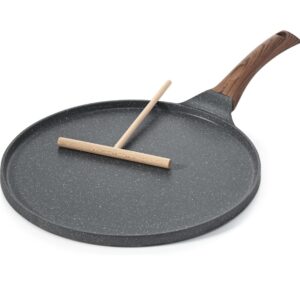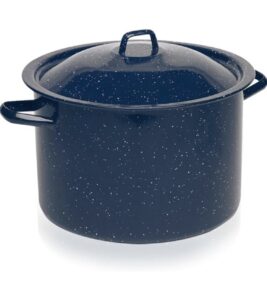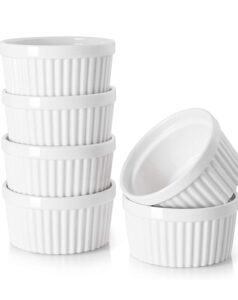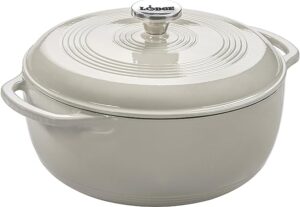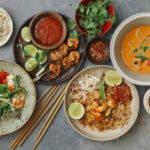2024 Majestic Culinary Adventures: A Taste of La Belle Vie – Exploring the Glorious French Cuisine
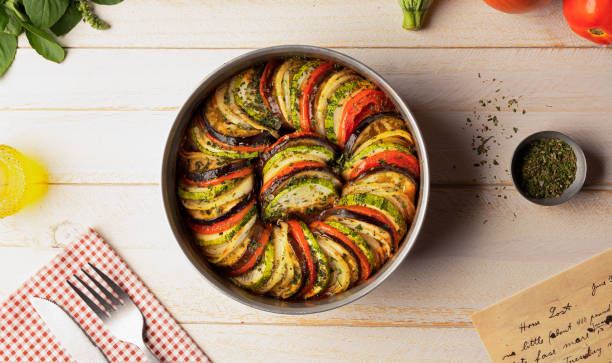
Bonjour, mes amis! Today, we’re whisking you away to the enchanting world of French cuisine—a timeless tradition that continues to reinvent itself with trends and flavors of the future. From the opulence of royal courts to the sustainable and innovative approaches of modern gastronomy, French cooking remains a celebration of artistry and tradition. Fear not, because we’ve gathered all the insider tips on recreating these French delights at home, along with the essential tools you’ll need for success.
French cuisine is a culinary marvel that has captivated the world for centuries. From the bustling bistros of Paris to the quaint countryside cafés of Provence, French food reflects the country’s rich history, diverse regions, and unwavering commitment to culinary excellence.
Louis XIV’s Culinary Court: Pioneering French Gastronomy
During Louis XIV’s reign, French cuisine reached new heights of sophistication and refinement. The royal court was a hotbed of culinary innovation, with chefs competing to create more elaborate and extravagant dishes. French gastronomy became synonymous with luxury and indulgence, setting the standard for haute cuisine worldwide.
The Rise of Bistros: Democratizing French Cuisine
In the 19th century, the rise of the bourgeois class led to the democratization of French cuisine. Bistros and brasseries sprung up across the country, offering hearty, rustic fare to the masses. Dishes like boeuf bourguignon, coq au vin, and cassoulet became beloved staples of French home cooking, celebrated for their simplicity and flavor.
Today’s Landscape: A Tapestry of Flavors in French Cuisine
French cuisine continues to evolve, blending traditional techniques with modern sensibilities and global influences. From Michelin-starred restaurants to neighborhood bistros, you’ll find a rich tapestry of flavors and textures celebrating the best French gastronomy.
Emerging Culinary Trends in French Cuisine (2024)
French cuisine is at an exciting crossroads in 2024, where tradition meets innovation in incredible ways. This year, hyper-regional cooking is taking center stage, with chefs reinvigorating dishes that celebrate the heart and soul of France’s provinces. Imagine enjoying aligot, a creamy, garlicky cheese and mashed potato dish from the Auvergne region, or savoring the delicate flavors of quiche Lorraine, made with fresh, locally sourced ingredients. These nostalgic dishes, once tied to specific regions, are now gaining global recognition. Alongside these revivals, contemporary chefs are reinterpreting beloved classics. A humble croque monsieur, for instance, may now feature artisanal bread, truffle butter, and locally cured ham, elevating it to a work of culinary art.
Another exciting trend is the rise of plant-based French cuisine. While rich creams and buttery pastries have long defined this gastronomy, vegan and vegetarian twists on classic dishes are redefining what French cooking can be. Think lentil cassoulet, dairy-free béarnaise sauce, and tofu-based quiches that capture all the flavor but leave a lighter environmental footprint. Even at elite Michelin-starred restaurants, chefs are embracing balance and creativity, ushering in a new era for French cuisine.
Essential Cookware Guide For French Cuisine
1. Crêpe Craze: Mastering the Art of Crêpes
Let’s start our journey with crêpes – those delicate, paper-thin pancakes that are a quintessential part of French gastronomy. To achieve crêpe perfection, you’ll need a crêpe pan – ideally non-stick with a low, sloping edge. Whether you’re serving them savory with smoked salmon and sour cream or sweet with a dollop of fruit compote, a quality crêpe pan is essential for achieving that golden, lacy perfection.
2. Bouillabaisse Bash: Dive into Seafood Delights
Ah, bouillabaisse – the iconic fish stew that hails from the sunny shores of Marseille. To whip up a pot of this flavorful dish, you’ll need a sturdy stockpot that can handle the abundance of seafood and aromatic herbs. Look for one with excellent heat distribution to ensure your bouillabaisse simmers to perfection, infusing every spoonful with the essence of the Mediterranean.
3. Soufflé Soirée: Elevate Dessert with Airy Delights
Get ready to elevate your dessert game with a soufflé soirée! These airy, decadent delights require a special soufflé dish to achieve their lofty heights. Look for one with straight sides and a smooth interior to help the soufflé rise evenly. Whether you’re going sweet with chocolate or savory with cheese, a quality soufflé dish is a must-have for any French-inspired feast.
4. Coq au Vin Celebration: Braising Perfection in a Dutch Oven
Fire up the stove for a coq au vin celebration! This classic French dish of chicken braised in red wine requires a sturdy Dutch oven to achieve its rich, savory flavors. Look for one with a tight-fitting lid and excellent heat retention to ensure your coq au vin cooks to tender perfection. Serve it up with crusty bread and a glass of wine for a true taste of France.
5. Ratatouille Revelry: Vibrant Vegetable Stew in a Sauté Pan
Take a trip to the south of France with a ratatouille revelry! This vibrant vegetable stew is a celebration of summer produce and sunshine. To make a pot of this colorful dish, you’ll need a wide, shallow sauté pan to ensure even cooking and caramelization. Whether you’re enjoying it as a side dish or a vegetarian main course, ratatouille is sure to delight your taste buds.
6. Café au Lait Soirée: Ending with a Classic French Brew
No French feast is complete without a café au lait soirée! Brew up a pot of strong coffee and serve it in classic French café au lait bowls for an authentic touch. Whether you’re enjoying it with breakfast pastries or dessert, café au lait is the perfect way to end any French-inspired meal.
Sustainability in French Cuisine
French cuisine has always championed seasonality and quality—a foundation that makes it perfectly suited for today’s sustainability movement. In 2024, chefs and home cooks alike are doubling down on these values, focusing on farm-to-table initiatives and reducing food waste. Seasonal ingredients such as earthy root vegetables in winter or bright, sun-ripened tomatoes in summer now take center stage, ensuring that dishes taste their best while minimizing their environmental impact.
Zero-waste cooking is also revolutionizing French kitchens. Imagine making a fragrant vegetable stock from leftover carrot peels and leek tops or transforming stale baguettes into a delectable bread pudding. These small changes align with a broader, eco-conscious philosophy while keeping the spirit of French culinary ingenuity intact. Sustainability doesn’t just extend to the food—it’s also reflected in the tools used. Durable, multi-functional cookware like stainless steel or cast-iron pots has become a staple for those looking to cook consciously without compromising on quality. By integrating these sustainable practices, French cuisine shows how tradition and responsibility go hand-in-hand.
Bon Appétit!
I hope you’re feeling inspired to whip up some authentic French eats in your own kitchen. With the right cookware and a touch of French flair, you’ll be cooking up a storm in no time. So grab your crêpe pan, stockpot, soufflé dish, Dutch oven, sauté pan, and café au lait bowls, and get ready to feast like a true Francophile! Bon appétit!
As you embark on your own culinary journey, remember that French cuisine is more than just a collection of recipes—it’s a way of life. By blending tradition, creativity, and sustainable practices, you can enjoy the essence of French gastronomy while reducing your environmental footprint. Whether you’re perfecting a delicate soufflé or brewing the perfect pot of café au lait, every dish tells a story of passion, artistry, and innovation. Bon appétit to a deliciously sustainable and flavor-filled 2024!
Read More:
Battle of the Pans: All-Clad vs. Hexclad Frying Pans
5 Easy Foods to Cook in Granite Skillets
5 Easy Foods to Cook in Your Cuisineart Saucepan
FAQs
- What are the key ingredients in classic French cuisine?
Classic French cuisine relies on high-quality, fresh ingredients that vary by region. Some staples include butter, cream, cheese, fresh herbs (like thyme and tarragon), garlic, shallots, wine (both red and white), and stock for soups and sauces. Beyond these, specific dishes highlight unique ingredients—like seafood for bouillabaisse or duck for confit de canard.
2. What essential cookware should I own to try French recipes at home?
To cook authentic French dishes, the following cookware is essential.
- A crêpe pan for sweet and savory crêpes.
- A Dutch oven for dishes like coq au vin or beef bourguignon.
- A sauté pan for stews like ratatouille.
- A stockpot for bouillabaisse or soups.
- A soufflé dish for desserts or savory soufflés.
High-quality cookware made of stainless steel, cast iron, or enameled finishes is recommended for durability and performance.
3. What are some sustainable ways to cook French dishes?
Sustainability can be incorporated into French cuisine by embracing seasonal ingredients, reducing food waste, and choosing eco-friendly cookware. For example, save vegetable scraps to make homemade stocks, repurpose stale bread for desserts like bread pudding, and prioritize local, organic produce. Opting for durable tools like cast iron or stainless steel cookware further aligns with sustainable cooking practices.
4. Are there vegetarian or vegan versions of classic French dishes?
Absolutely! Plant-based versions of French classics are becoming more popular. For instance, cassoulet can be made with lentils instead of meat, and dairy-free alternatives enable vegan versions of béchamel sauce and quiches. Many chefs are experimenting with using plant-based cream and butter substitutes to retain the richness French cuisine is known for while catering to vegan diets.

